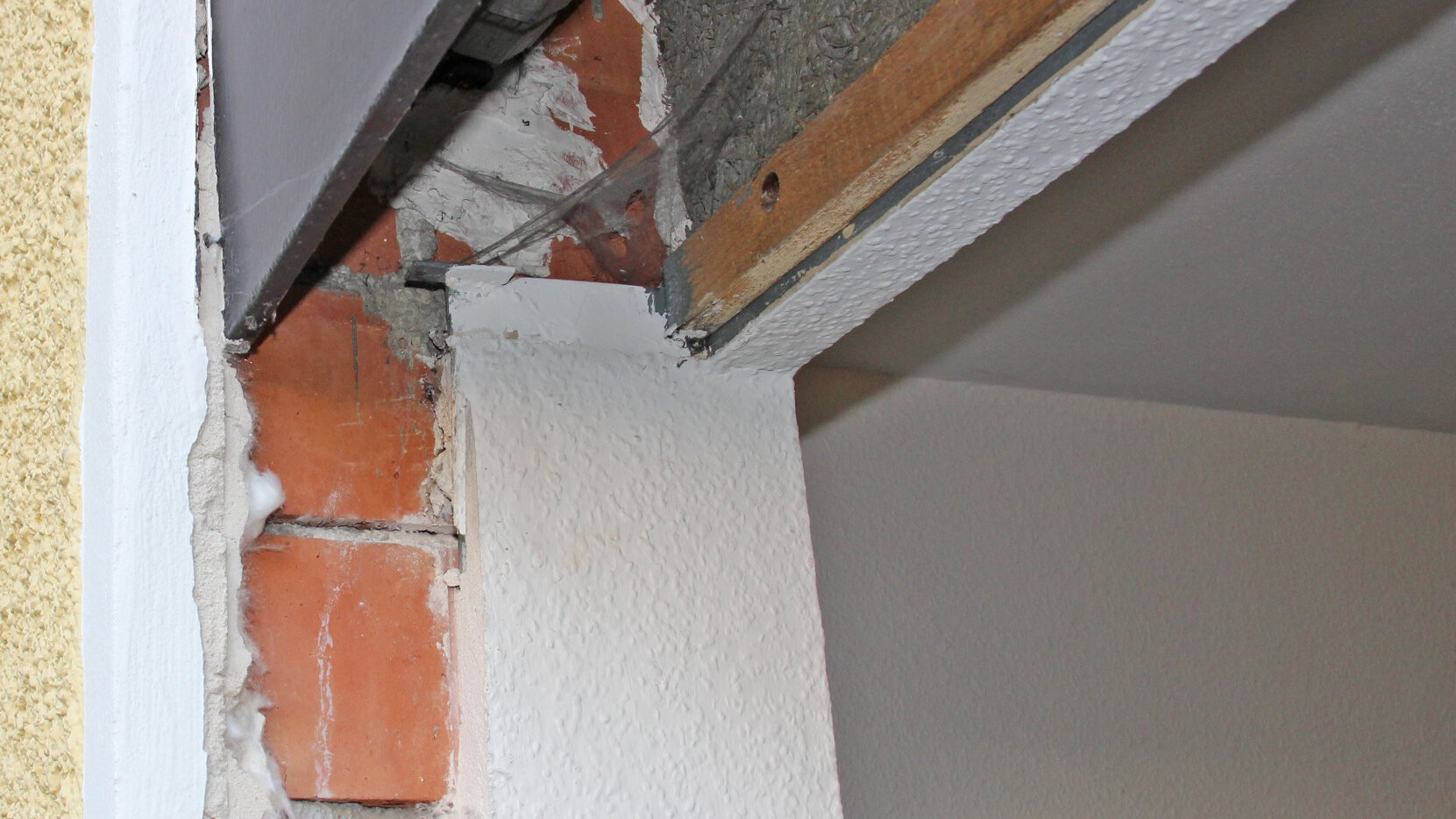Reading time: 1 minute
Building elements must meet their functional and aesthetic responsibilities for decades un-der extreme boundary conditions.
The choice of the proper windows, analysis and planning the interactions with respect to ventilation, proper skilled manual design and execution of critical details ensure trouble-free durability of construction products. Minor causes may have a major impact on the durability and suitability of use with unfavourable chain reactions of circumstances. In the process, there are constellations that occur regularly, of which three significant examples are being covered here.
Typical sample 1: Maximum requirements – minimal effort
In particular, private building owners express the desire that window replacement should be done without any major damage and without any comprehensive extra construction work. Statements such as "Window replacement without dirt" are popular with advertising campaigns that support this expectation. It has been demonstrated in practice that these requirements, in the case of old constructions
– with the construction materials used at that time,
– with the additionally installed elements such as window sills and roller shutter housings,
– in the existing mounting position in the wall
without additional construction measures that can almost never be achieved. The execution of all measures necessary for avoiding thermal bridges, for implementing a ventilation concept etc. is not ordered out completely by building owners and executed in the same way. Thus, the job of refurbishment remains incomplete and becomes due with respect to problems pertaining to dew point performance and formation of moulds. The interactions are illustrated in Figure 1; they need to be considered with a detailed analysis of the building and clarified in the course of providing sincere advice to the building owners.
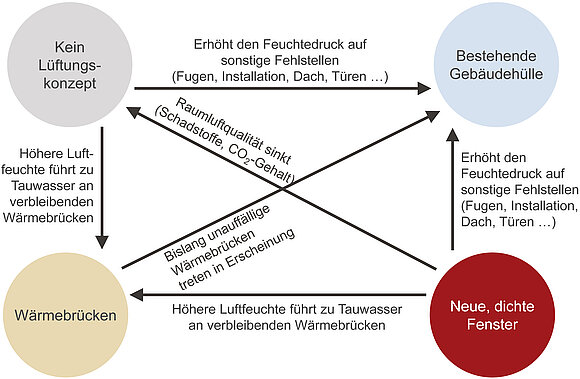
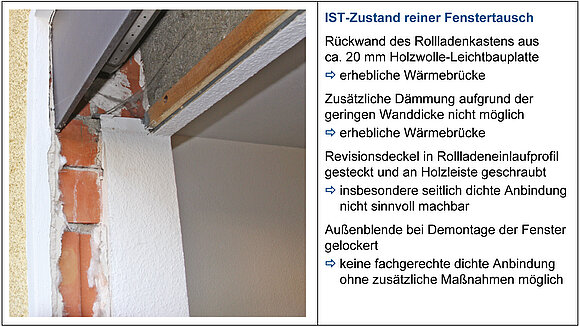
The actual objective of achieving substantial savings in energy consumption for the building without the problems associated with dew and moulds is possible only with a comprehensive refurbishing concept (Figure 2).
Typical sample 2: The fine print is overlooked
In the meantime, there are a number of materials and supplier products that ensure the function of the window, facilitate the work of connecting them to the wall, improve cleaning and maintenance and thus, maintain suitability of use in the long run. In the process, the products are always only effective if
- you comply with their area of application (e.g. maximum weights, adjacent materials, specific loads ...)
- they are processed properly (e g. ambient conditions, preparatory steps, execution of details (see Figure 3) ...)
- maintenance and care is done as specified.
These conditions are documented by manufacturers in most cases in detail and clearly in the instructions for processing. Any deviations from these generally lead to the situation that the function and / or the durability cannot be certified any longer.
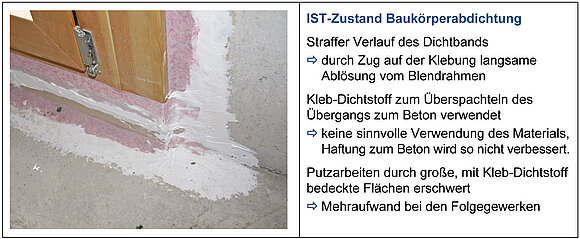
Typical sample 3: Stresses are underestimated
In case of disputes concerning the execution of construction work, the sentence "This is how we have always done it" is used regularly. The background is the assessment on several occasions that changing circumstances for loads, statutory specifications and the expectations of the building owners cannot be met with the "traditional" manner of execution (moreover, the subject of "Typical sample 1" also is an issue lingering in the background).
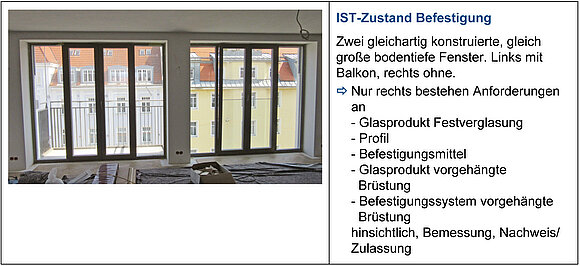
In particular, for example, for the fixture, a subtle process has been deployed in the last few years, which has escalated with increasing window sizes, increasing window casement weights and reducing strength of wall bricks. The improved specifications for designing and dimensioning fasteners and fixing elements as they are specified in the guideline for installation must be implemented urgently in practice. Similarly, fixing the safety barrier building components that have been necessary, specified and proven since a long time, has been demanded frequently in the meantime. Tests to verify these retrospectively fail in most cases on account of the fasteners or fixing materials that have been dimensioned inadequately or are not verifiable.
Summary
Separate constellations of
- pressure on cost and time
- unforeseen influences
- lack of planning and coordination of interrelated craftsmanship
and the samples mentioned
- Diligence and care when using the materials
- Increase in loads
lead to defects and damage. The proverbial saying goes like "You learn by making mistakes"; but considering the high costs and other trouble involved, you can, in any case, do well without this manner of gaining know-how in construction. The building constructions at present are far too developed for a "Nothing will go wrong" philosophy. Practically all defects have their origin in inadequate planning and preparation. Shortcomings in design and planning must be attended to and rectified immediately, since spontaneous "creative" solutions on-site do not improve the situation.
Literature
- RAL guideline for the planning and execution of the installation of windows and exterior doors: RAL-Gütegemeinschaft Fenster und Haustüren e.V. (Quality Assurance Association for Windows and Doors) or Bundesinnungsverband des Glaserhandwerks (The Federal Association of Glazier Trades (BIV), March 2014
